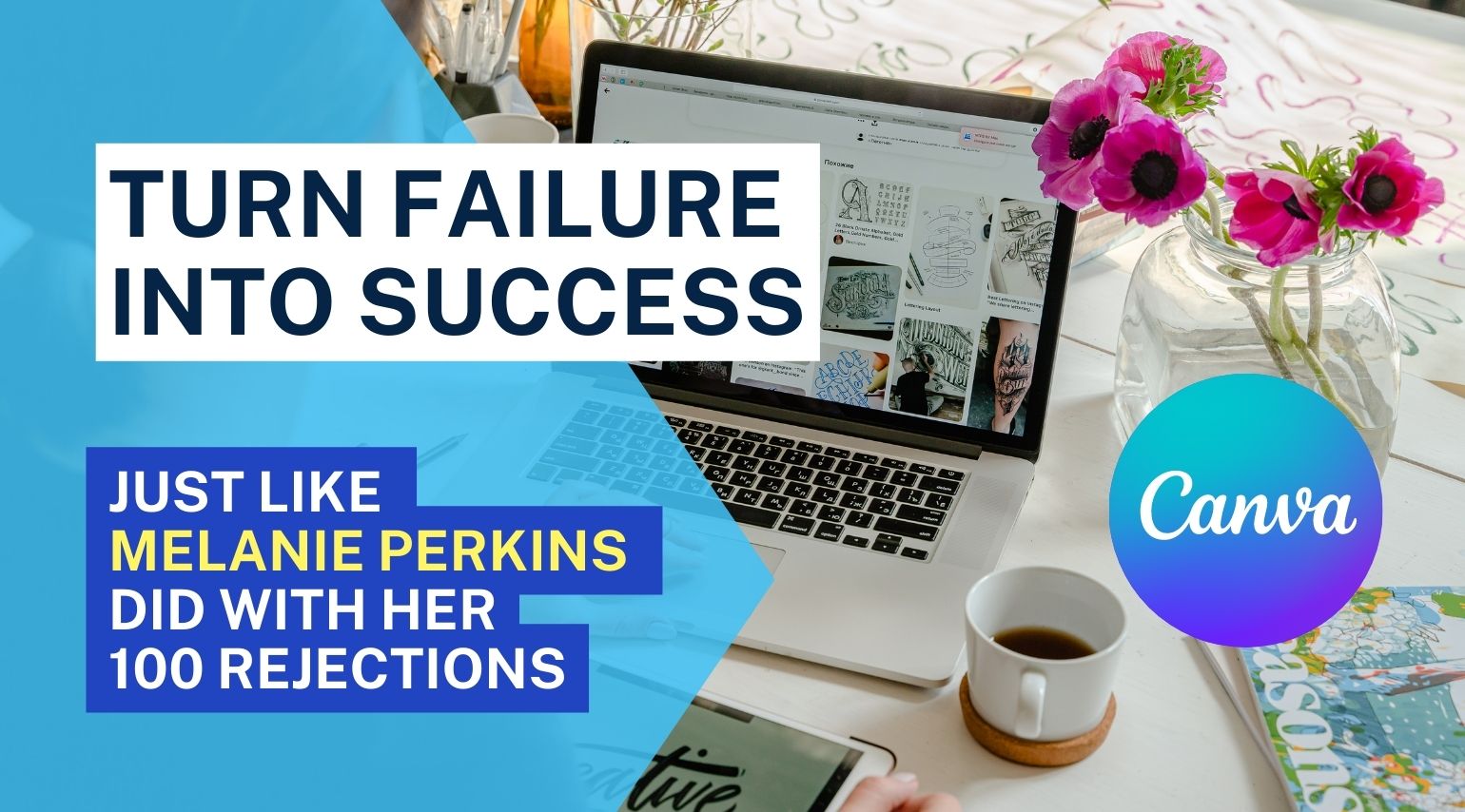The Success Story Of Canva Co-Founder Melanie Perkins
The Constant Rejections were Turned to the Rise of Canva Co-Founder Melanie Perkins
People are reinventing the graphical format as the globe moves toward a more technological environment. With this in mind, the business titans launched a number of animation and graphic design platforms. Nonetheless, they fell short of the top rank in the sector. Canva is the one standing tall!
To say that Canva has caught the world’s imagination is an understatement, considering that it has given millions of creative people throughout the world wings.
It is plausible to draw a direct comparison between Canva’s successes in popularising and making graphic design simple to mobile cameras’ contributions to popularising photography amongst those who have never used a camera before.
Melanie Perkins, the co-founder of Canva, would unquestionably get the credit if it were to be given to just one individual. Melanie Perkins persevered with her fundamental concept despite receiving more than 100 rejections from investors.
To build a straightforward design interface that anybody could use without a prior understanding of creating software, a simple yet transformative notion defeated desktop publishing behemoths like Adobe and Microsoft.
Melanie developed the concept in 2007 while instructing a group of students in graphic design at a university in Perth, Australia. At the time, she was just 19 years old. The graphic design software was outrageously pricey in addition to being difficult to master and taking months to comprehend all of the settings and buttons.
The idea behind Canva was to develop an internet platform that would make graphic design incredibly accessible for everyone and enable anyone to produce stunning graphics.
She persisted and accepted criticism well, and it paid off since the business is now worth $40 billion. Canva is now the sixth most valuable unicorn in the whole world.
Most people today are aware of the online design tool, but they are less familiar with Perkins' background, how she founded the business and her future intentions for the sector. She is, however, one of the finest examples of how a transformative servant leader can start a successful company.
Learn more about Perkins' life narrative and management philosophy below.
Foundations of Melanie Perkins' Entrepreneurship
Melanie Perkins knew she wanted to start her own business from a young age. At the age of 14, she started making scarves and selling them to markets and shops in Perth, Australia.
Perkins created her first company a few years later, while she was a student at the University of Western Australia. Her real-world experience teaching graphic design to schoolchildren inspired this concept. She saw the challenges individuals had while attempting to learn how to utilize software like Adobe Photoshop.
Fusion Books was established in 2007 by Perkins and Cliff Obrecht in an effort to address a real-world issue. From the comfort of her mother's living room, the company provided internet services for printing and designing school yearbooks. The pair realized they needed to start small and grow later because they had little expertise in running a business or selling a product.
Because of the company's success, Perkins left college. Within five years, Fusion Books surpassed all of its rivals and was the most well-liked yearbook supplier in Australia.
Melanie Perkins, though, wasn't happy to stop there. She had a bigger goal in mind: to make graphic design simple and available to everyone. The two set out to create a new company together with Obrecht's assistance as the co-founder of Canva.
Failures and rejections were a constant
Perkins and Cliff Obrecht sought to build on their work with Fusion Books in 2011. Letting people make any design was the straightforward concept behind Canva. This includes things like business cards, social media postings, eBooks, and wedding invites (without needing a degree in graphic design).
The online design platform, which was template-based and easy to use, provided a significant solution for those who wanted to design something but did not have the necessary skills. Canva altered the specifications necessary to create high-quality designs by providing this service without charge.
However, investors weren't persuaded. More than 100 times Perkins and Obrecht were fired. “Although the failure was never an option, rejection stings a lot. For better or worse, I don't give up very readily at all when I set my mind to anything. Being turned down frequently during our early phases really forced me to work harder and hone my approach”, Perkins said in a lecture at a Blackbird Ventures event about her experience with failure and how to learn from it.
Melanie Perkins resisted giving up in face of persistent rejection. She would do anything to ensure the success of her business, even learning to kitesurf.
Networking was the key because all that matters is who you know
In 2011, Bill Tai, a Silicon Valley venture financier who supported hugely successful businesses like Zoom and Wish.com, was presented Canva by Perkins and Obrecht. Tai is a major enthusiast of kiteboarding as well. Perkins started playing the sport after realizing that this was the best way to develop connections with several possible investors. She told Forbes when they interviewed her in 2019 that "once you get your foot in the door just a little bit, you have to kind of wedge it all the way in" on Richard Branson's Necker and Moskito islands.
By inviting Perkins to events like his MaiTai kitesurfing vacation, Tai soon introduced him to a number of influential people in Silicon Valley.
As the creator of Canva made increasingly frequent journeys to San Francisco, he encountered a group of individuals who would help Canva become a household name. This included Rasmussen, their tech guru, and Cameron Adams, a developer and former Google user interface designer, who became a co-founder of Canva as well. Additionally, Canva hired Dave Hearnden, a software engineer who formerly worked on Google Maps and Wave. Meeting these individuals, who had a significant impact on Perkin’s vision and assisted her in addressing it, is what she attributes to the company’s success.
Canva’s journey to the top
After raising a few million dollars the year before, the firm started in 2013. After the design platform launched and demonstrated profitability through a subscription model for premium services, the number of investors swiftly expanded. By March 2013, Tai and Rasmussen, together with other American private equity firms and angel investors, had contributed another $3 million to the team's fundraising efforts. Anyone who had any doubts about Canva's ability to succeed could see its promise with the 750,000 users it had at the end of 2013.
The startup obtained Series A investment in 2015. Owen Wilson, Woody Harrelson, Blackbird Ventures, Matrix Partners, and Vayner/RSE were among the investors. Canva received a Series B investment the next year.
According to Blackbird Ventures partner Rick Baker, "Melanie Perkins and her team have taken the firm from modest beginnings in Australia to what has now bloomed into one of the fastest-growing software enterprises of all time in just four years."
Canva has received Series E investment thus far, which is nearly unheard of for start-up companies. The company's current market value is 40 billion as of 2021, after having raised 572.6 million. Canva is currently one of the most popular graphic design tools available, being utilized by 85% of Fortune 500 organizations. In 190 of the 195 nations in the world, the company reportedly has more than 60 million monthly users.
Melanie Perkins: The defining example of disruptors
Google searches for "Canva vs. Photoshop" get 1,400,000 results, giving proof of exactly how revolutionary Canva is. It is astounding that a newbie to the market can compete with a best-selling program that was released in 1987.
In a lecture for World of Business Ideas, Malcolm Gladwell, the best-selling author of Outliers, emphasizes that people who disrupt their sectors must be:
- Open: A person who is imaginative, receptive to fresh perspectives, and acceptive of new ideas.
- Conscientious: The individual must exercise self-control and follow through on their original thoughts.
- Disagreeable: Disruptors don't require peer approval from the outside world in order to pursue their ambitions, in addition to the two attributes mentioned above. Instead of following what other people advise them to do, they will follow their own moral convictions.
All three describe Melanie Perkins.
She competes with Adobe and Microsoft today because of her success with Canva.
Her openness, conscientiousness, and disagreeableness haven't changed despite all of her achievements. According to her, a corporation is in its infancy when its aspirations are far greater than its actual size. They definitely fall within that group. But she claims that there’s a longer route to travel as they've only made it 1% of the way.
Her belief in giving to the society
Despite leading the #1 unicorn business in the world run by a woman, Perkins’ calendar is never too packed to be a great leader. She benefits her staff by onboarding each new recruit individually (which is now more than 1.5K people). She discusses her vision for the company, her team’s culture, and the investor's deck with thyme at this discussion. Additionally, all staff members have the chance to acquire stock options, which are equivalent to 5% of the company (around 2 billion).
Canva also gives back in a variety of different ways, including by providing free premium services to teachers and charity groups.
Despite Canva’s success, Perkins is an entrepreneur who isn’t obsessed with accumulating cash to live luxuriously. She cares much more about what money can achieve for others than she does for herself, as seen by the $30 engagement ring she chose. She probably won’t ever sell her company shares as a result.
She and Obrecht promised to donate 12 billion (30% of the business) in 2021 to the effort to end severe poverty. During a press conference, Perkins stated, "We believe there is enough money and enough goodwill in the globe to address most of the world's issues."
It simply goes to demonstrate that Perkins and Obrecht are decent individuals in addition to being successful businessmen.
You now understand that when you use Canva to create anything in the future, you are helping a company that is dedicated to resolving the world's most pressing issues.
Our last words to you:
Never give in to the naysayers, since the simplest thing in the world to find is someone who can tell you a laundry list of reasons why your great idea will fail. People are often afraid that you may attain your ambition when they have not. It's time to disprove them.
Since she was young, Melanie has wanted to develop a platform that can streamline the entire graphic design process. She lacked the resources to start her idea, let alone expand it widely. She did, however, believe in her. Her efforts and difficulties have paid off, and her goal is now a reality.
No easy task, but as the saying goes, if you shoot for the moon, the worst that may happen is that you'll fall on a star. You may build the next unicorn by following Perkins' example and putting yourself in a position for success. Even fairy tales may come real.












